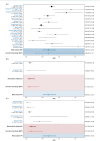Improving pediatric multiple sclerosis interventional phase III study design: a meta-analysis
- PMID: 35514529
- PMCID: PMC9066624
- DOI: 10.1177/17562864211070449
Improving pediatric multiple sclerosis interventional phase III study design: a meta-analysis
Abstract
Background: To support innovative trial designs in a regulatory setting for pediatric-onset multiple sclerosis (MS), the study aimed to perform a systematic literature review and meta-analysis of relapse rates with interferon β (IFN β), fingolimod, and natalizumab and thereby demonstrate potential benefits of Bayesian and non-inferiority designs in this population.
Methods: We conducted a literature search in MEDLINE and EMBASE from inception until 17 June 2020 of all studies reporting annualized relapse rates (ARR) in IFN β-, fingolimod-, or natalizumab-treated patients with pediatric-onset relapsing-remitting MS. These interventions were chosen because the literature was mainly available for these treatments, and they are currently used for the treatment of pediatric MS. Two researchers independently extracted data and assessed study quality using the Cochrane Effective Practice and Organization of Care - Quality Assessment Tool. The meta-analysis estimates were obtained by Bayesian random effects model. Data were summarized as ARR point estimates and 95% credible intervals.
Results: We found 19 articles, including 2 randomized controlled trials. The baseline ARR reported was between 1.4 and 3.7. The meta-analysis-based ARR was significantly higher in IFN β-treated patients (0.69, 95% credible interval: 0.51-0.91) versus fingolimod (0.11, 0.04-0.27) and natalizumab (0.17, 0.09-0.31). Based on the meta-analysis results, an appropriate non-inferiority margin versus fingolimod could be in the range of 2.29-2.67 and for natalizumab 1.72-2.29 on the ARR ratio scale. A Bayesian design, which uses historical information for a fingolimod or natalizumab control arm, could reduce the sample size of a new trial by 18 or 14 patients, respectively.
Conclusion: This meta-analysis provides evidence that relapse rates are considerably higher with IFNs versus fingolimod or natalizumab. The results support the use of innovative Bayesian or non-inferiority designs to avoid exposing patients to less effective comparators in trials and bringing new medications to patients more efficiently.
Keywords: annualized relapse rate; clinical trial design; fingolimod; interferon; natalizumab; pediatric-onset multiple sclerosis; systematic review.
© The Author(s), 2022.
Conflict of interest statement
Conflict of interest statement: The authors declared the following potential conflicts of interest with respect to the research, authorship, and/or publication of this article: J.S.G. over the past year received grant/contract research support from the National Multiple Sclerosis Society, Biogen, and Octave Biosciences; she serves on a steering committee for a trial supported by Novartis; she has received honoraria for a non-promotional, educational activity for Sanofi-Genzyme; she has received speaker fees from Alexion and Bristol Myers Squibb (BMS) and served on an advisory board for Genentech. M.T. and J.L. are the employees of Novartis Pharma AG. A.S. is an employee of Novartis Healthcare Pvt. Ltd. A.G. was an employee of Novartis at the time of article development. M.R.L., H.S., and D.A.H. are the employees of Novartis Pharma AG. T.F. reports personnel fees for consultancies (including data monitoring committees and steering committees) from Bayer, Biosense Webster, Boehringer Ingelheim, Coherex Medical, CSL Behring, Daiichi Sankyo, Fresenius Kabi, Galapagos, Janssen, LivaNova, Novartis, Penumbra, Roche, and Vifor. J.G. reports consultant fees for research, lectures, and advisory boards from Bayer, Biogen, Novartis, Sanofi, and Teva; she also received financial support for a research project from Novartis.
Figures


Similar articles
-
Annualized relapse rate of first-line treatments for multiple sclerosis: a meta-analysis, including indirect comparisons versus fingolimod.Curr Med Res Opin. 2012 May;28(5):767-80. doi: 10.1185/03007995.2012.681637. Epub 2012 Apr 24. Curr Med Res Opin. 2012. PMID: 22462530
-
Cladribine vs other drugs in MS: Merging randomized trial with real-life data.Neurol Neuroimmunol Neuroinflamm. 2020 Aug 14;7(6):e878. doi: 10.1212/NXI.0000000000000878. Print 2020 Nov. Neurol Neuroimmunol Neuroinflamm. 2020. PMID: 32801167 Free PMC article.
-
Comparative Effectiveness and Cost-Effectiveness of Natalizumab and Fingolimod in Patients with Inadequate Response to Disease-Modifying Therapies in Relapsing-Remitting Multiple Sclerosis in the United Kingdom.Pharmacoeconomics. 2022 Mar;40(3):323-339. doi: 10.1007/s40273-021-01106-6. Epub 2021 Dec 18. Pharmacoeconomics. 2022. PMID: 34921350 Free PMC article.
-
Ocrelizumab versus fingolimod after natalizumab cessation in multiple sclerosis: an observational study.J Neurol. 2022 Jun;269(6):3295-3300. doi: 10.1007/s00415-021-10950-7. Epub 2022 Jan 4. J Neurol. 2022. PMID: 34982200 Free PMC article.
-
Estimating the comparative efficacy of cladribine tablets versus alternative disease modifying treatments in active relapsing-remitting multiple sclerosis: adjusting for patient characteristics using meta-regression and matching-adjusted indirect treatment comparison approaches.Curr Med Res Opin. 2019 Aug;35(8):1371-1378. doi: 10.1080/03007995.2019.1585779. Epub 2019 Mar 29. Curr Med Res Opin. 2019. PMID: 30786783
Cited by
-
Therapeutic Advances in Pediatric Multiple Sclerosis.Children (Basel). 2025 Feb 20;12(3):259. doi: 10.3390/children12030259. Children (Basel). 2025. PMID: 40150542 Free PMC article. Review.
-
Old and New Strategies in the Treatment of Pediatric Multiple Sclerosis: A Personal View for a New Treatment Approach.Neurol Ther. 2024 Aug;13(4):949-963. doi: 10.1007/s40120-024-00633-6. Epub 2024 Jun 1. Neurol Ther. 2024. PMID: 38822947 Free PMC article.
-
Adult and pediatric relapsing multiple sclerosis phase II and phase III trial design and their primary end points: A systematic review.Clin Transl Sci. 2024 May;17(5):e13794. doi: 10.1111/cts.13794. Clin Transl Sci. 2024. PMID: 38708586 Free PMC article.
References
-
- Oh J, Vidal-Jordana A, Montalban X. Multiple sclerosis: clinical aspects. Curr Opin Neurol 2018; 31: 752–759. - PubMed
-
- Jeong A, Oleske DM, Holman J. Epidemiology of pediatric-onset multiple sclerosis: a systematic review of the literature. J Child Neurol 2019; 34: 705–712. - PubMed
-
- Macaron G, Feng J, Moodley M, et al. Newer treatment approaches in pediatric-onset multiple sclerosis. Curr Treat Options Neurol 2019; 21: 50. - PubMed
-
- Storm Van’s Gravesande K, Blaschek A, Calabrese P, et al. Fatigue and depression predict health-related quality of life in patients with pediatric-onset multiple sclerosis. Mult Scler Relat Disord 2019; 36: 101368. - PubMed
LinkOut - more resources
Full Text Sources

